Topic: Military Theory

Tactical Consideration (1855)
Under the head of Marches, we are reminded of Marshal Saxe's profound dictum, that the whole secret of war is in "the legs."
From: Field Service; The Sydney Morning Herald, Sydney, Australia, 11 May 1855
(From the Household Words)
From an interesting chapter on strategical science, we learn, among other things, that "a gentle slope is the most advantageous ground to have in front of a battery;" and that "fifty to one hundred and fifty yards of soft marshy ground, where the enemy's shot would sink; gullies or ravines crossing the enemy's fire at right angles, with a terrace of six to ten feet elevation, about twenty paces in front of a battery; are all good obstacles to the enemy's fire." This almost describes, verbatim, the best points of the Russian position above the Alma.
Some curious facts and calculations relative to the distance and proximity of an enemy, so important to be judged of in warfare, are set forth by the same authority. It is calculated that if the enemy's cavalry are one thousand yards off when they begin to move, they will take about seven minutes to come up—first at a gentle trot, then at a round trot, and finally at a gallop; and, during this interval, each gun can discharge at them, with great precision, ten rounds of round shot and four of case shot (that is, shot put up in a cylinder); or about one round every half minute. This is exclusive of the fire of the infantry with their small arms. The effects of a steady fire may be instanced in what took place at Dresden under napoleon's eye. A body of eight thousand splendid Austrian cavalry dashed down an easy slope at the French—a terrible sight to a young recruit but on this occasion they were met by the Emperor's Old Guard, who were used to it. They reserved their fire till the enemy were close upon them; and when they did fire, and the smoke had cleared away, four thousand of that immense host were on the ground, either killed or dismounted by the death of their horses.
At two thousand yards off a single man or horse looks like a dot; at twelve hundred yards infantry can be distinguished from cavalry; at nine hundred the movements become clear; at seven hundred and fifty yards heads of columns can be made out. Infantry marching send out strong lights; and, if the reflection be brilliant, it is probable that they are marching towards you. The dust raised by cavalry and artillery forms a thick cloud; but this is fainter when caused by infantry.
Under the head of Marches, we are reminded of Marshal Saxe's profound dictum, that the whole secret of war is in "the legs." Marches preface the victories, which battles decide, and pursuit completes. The order of march of an army is this,—infantry, artillery, baggage, cavalry; and a column of thirty thousand men this disposed, would occupy three miles, and would require two hours at least to range in two lines of battle. A day's march with the lightly armed Romans was eighteen and a half miles; but, for ordinary armies in more modern times fifteen miles is allowed, in consideration of the artillery, baggage, and other impediments. But we must not overlook what can be done on extraordinary emergencies.
For instance, General Crawford astonished even the Duke of Wellington, when he joined him after the battle of Talavera, with his light brigade, having marched sixty-two miles in twenty-six hours. Lord Lake's cavalry gallop of seventy-three miles, to the scene of Holkar's defeat at Furruckaband, was performed in the same number of hours. In forces marches, the greatest obstacle to the infantry is blistered feet, to prevent which, feet should be greased well beforehand. Tallow dropped from the candle into common spirits, and rubbed well into the feet, is a cure of blisters already raised. The ordinary quick step is equal to three miles an hour; but this race cannot be kept up after the first hour or two. Double quick is at the rate of seven miles an hour. On parade, a military pace is thirty inches, two thousand one hundred and twelve of which equal a mile.
Where troops sleep without cover—as we know will sometimes happen with the best-regulated armies—and must often happen in armies under red-tape rule, in which the men are governed by the general, their food by the commissariat, and their tents by the ordnance; each department utterly independent of the other—they sleep with their feet towards the fire (one fire to six men); but in a marshy country they should be made to sleep between two fires, which promotes a free circulation of air—the great secret of health where fever and ague are prevalent. A useful cookery hint:—Take your ration of meat, wrap it in a piece of paper or cloth, and cover it with a crust of clay; then you may bake it in any sort of holes well covered over with red-hot embers; and with good economy too, for not a jot of the juice of the meat is lost.

